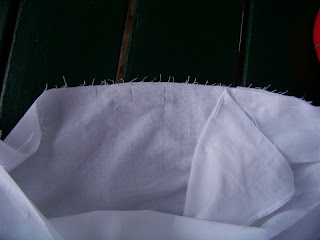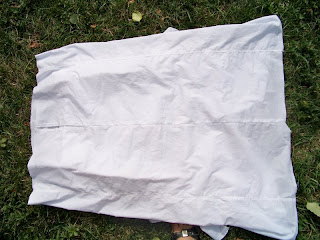
This skirt was supposed to debut at Thanksgiving, but because I sew in short spaces between work, babycare and household tasks, it was only Christmas Eve, early in the morning, that the last ruching was completed. I wore it to Christmas Eve service and then to a dinner date at Jonathan's on Saturday, and now again to a lunch date.
Photo: the skirt debuts
The skirt panels (there are only two!) and side placket closure are copied from a plain denim skirt my mother owns and that I have always admired the fit of, but the rest is my design: I used no waistband, facing the interior instead, and sandwiching a full-length lining there; I also faced the bottom with a 2-inch hem for better hang, and of course, adding the ruche :}

The ruche idea originated as I was reading Frances Grimble's The Lady's Stratagem: so many skirts of the late 1820s focus attention on the skirt hem, and the general lightly A-line cut with slim hips was popular too. I thought, ooh, ruches are popular this year, and wouldn't it be fun to see a little ruche flutter near my feet!
Photo: skirt front
Construction
I made the skirt using, excepting the bag lining, generally period methods...from herringboning hems to placket construction to the hand-gathered and feathered ruche. The extra care makes the skirt sturdier and certainly makes the interior feel more finished. :}
The skirt panels: traced and cut
The skirt is constructed of only two panels, front and back. They are shaped with a curve at the hips on the side seams and a slight A-line cut. There is no need for darts at the waistline, at least in my case. To copy the panels from my mother's skirt, I laid the lining fabric out on one of those fold-up cardboard boards marked with inches that Hancock's sells, pinned the skirt as flat on top as I could, and traced around the edge with tailors chalk. First I made sure that back and front were the same cut... Jennie Chancey has instructions, titled How to Make a Pattern from a Favorite Garment for copying a pattern on her Sense and Sensibility Patterns site.
After pinning the lining together and trying it on to test fit it, I cut out the fashion fabric by using the lining piece as a pattern. At the same time, I traced the bottom curve of the skirt over scrap fabric and cut out a two-inch hem facing (with extra for seam and hem allowances), then repeated the process at the waistline for a waist facing.
Seaming
Next I pinned, basted and stitched up the side seams, and left them raw since the wool doesn't ravel badly and there is a lining to protect it. I left one side with a nine or so inch unsewed space at the top for the placket.
Then I pinned, basted and stitched the lining's side seams, again leaving room for a placket and machine-hemmed the lining bottom.
Attaching the lining: a sandwich effort
Then it was time to attach the lining to the skirt. I made a "sandwich": the raw top of the waist facing and raw top of the skirt right sides together, with the raw top edge of the lining in between. I pinned, basted and stitched it. I then trimmed the seam allowances very close to the stitching to reduce bulk, turned the facing inwards, and voila, the lining was attached and the seam hidden. To prevent the facing from rolling towards the outside when the skirt was worn, I carefully edge-stitched the skirt top from the outside.
I feel very fortunate to use a Willcox and Gibbs chainstitch machine: the presser foot is very narrow indeed, has a super grip on the feed dogs, which are also placed close together, and I use an extremely sharp needle. This helps me to sew neatly (usually) very, very close to the edge of the fabric: a wider presser foot would make it harder to see what I was doing, and the wider-set feed dogs would have a harder time gripping the fabric, because only one side would probably be gripped. Here are some shots of the machine from an 2006 post.
The skirt placket
Next, the placket. I made both underlap and overlap pieces for this skirt, as the wool is thin and needs some extra body. The original skirt just had an underlap, but that skirt was denim. Instructions on making this sort of placket are covered in a previous post, titled Edwardian and Victorian Skirt Plackets: Where to Find How Tos.
One nice little touch: Chapter XV of Frances Grimble's The Lady's Strategem, titled "The Art of the Mantua Maker or Cutter of Gowns", covers what was then called "plain sewing" in quite a bit of detail, as she has translated sewing manuals from French. At that time seamstresses made quite a bit of use of tight overcasting to finish edges of fabric, and to seam two pieces of fabric together!
Since I didn't want to create unnecessary bulk where the underlap and overlap are joined at the bottom, I pinned the two pieces together and tightly overcasted them, placing the stitches very close together, to prevent ravelling of the raw edges, and the stitches just far enough back from the raw edge to hold the seam securely. This method probably would not work on seams that get a lot of stress or with ravelly fabric. Here, however, it prevented me from having to hem or otherwise finish the bottom of the placket and so doing, create extra bulk.
Interior finishes, fasteners, and facings

Next, interior finishes at the waistline and lining placket: I roll-hemmed the edges of the lining at the placket opening, and carefully herringbone stitched the lower edge of the waist facing down onto the lining (not catching the real skirt fabric, however). Herringbone stitches have give to them, so they can take a little pulling, and they look neat! You see them used in the linings of older nicely tailored coats, for instance. If you've never used a herringbone stitch before, check the manuals at http://www.VintageSewing.info.
Photo: interior finishes at the placket. If you click on the image to see the large version, you'll probably spot the place where my vaunted neat edge stitching wavered a bit!
Let's see, after that, I attached the hem facing at the skirt bottom...same method as the waist facing, but without
 sandwiching the lining, as the lining hangs free. I hemmed it to the inside of the skirt carefully with what the Regency era called "side stitches" and later eras called a hemming stitch.
sandwiching the lining, as the lining hangs free. I hemmed it to the inside of the skirt carefully with what the Regency era called "side stitches" and later eras called a hemming stitch.Then it was on to attaching hooks and eyes and snaps. I do not like zippers, as a matter of taste. As for using both hooks and eyes and snaps, some Edwardian manuals suggest putting a few hooks and eyes up top, then snaps lower down, where there is less stress. So that is what I did.
Photo: herringbone stitches attach the waistline facine to the lining. You may note that there is an incipient wrinkle in the facing: I gained a little weight at Christmas and gracious, if it isn't stressing the skirt! I had it fitting very closely, you see. Hmmm.
The ruche
At last, the ruche. I used fabric on the straight of grain rather than the bias, since I like the body of it. I cut it three inches wide (I wanted a bold effect!), cutting two lengths twice the length of my skirt hem circumference. After seaming them into one long length, I sewed a tight stitch straight down each long side about a half inch from the raw edge to try to control excessive fraying.
After this, I ruched. All this means is that I took a longish needle, threaded it, and sewed basting stitches down the longways middle of the fabric. I pushed several little gathers of fabric onto the needle before drawing the thread through; this helped the stitches be of even length and speeded the sewing. Every six inches or so I gathered the fabric and sewed a backstitch or two to hold that section so it wouldn't "ungather", then repeated the process.
By the way, 2x the skirt circumference was not long enough for a full ruche. I ended up having to cut another length, to ruche that, and to, carefully as I could, hand-seam it to the other pieces without showing. It worked pretty well. That's what can happen when you work by guess and by golly, no?
 After that? I "feathered" the edges of the fabric by laboriously pulling threads until I had a narrow fringe.
After that? I "feathered" the edges of the fabric by laboriously pulling threads until I had a narrow fringe.Photo: the ruche. Note the line of stitching near each feathered edge, to, I hope, control raveling a bit
The final step: I tacked the ruche down at precisely the level where the skirt facing was hemmed inside the skirt: this hides any showthrough of those hemming stitches :}
There you have it. I used lots of handwork for just a simply two-panel skirt, but I enjoy handwork, and the result is, I think, pleasing.
A thought about the fabric: it's a very lightweight wool plaid, in cocoa with blue and pink bars, so soft as to barely be seen and I believe the fabric is a worsted...I am not over-familiar yet with wools. It's from Hancock Fabrics, which each year seems to carry at least one very nice wool. Anyhow, the wool has a marvelous drape, but unlike heavier wools, is apt to wrinkle if sat upon long. I see some wrinkles in the front caused, I am sure, by holding warm little Christopher for almost an hour in the pew box...he'd act like a warm iron :}
























































